|
|
|
|
HYBRID BEARS |
All the Ursinae species (all bears except the giant panda and the spectacled bear) appear able to crossbreed and will do so if placed together; all have 72 chromosomes except for Spectacled bears (53 chromosomes) and Pandas (42 chromosomes). Hybrids not involving the Polar bear are on a different page.
BROWN BEAR X POLAR BEAR HYBRIDS
GERMANY’S POLAR-BROWN HYBRID BEARS (1874)
At Halle, starting in 1874 a series of successful matings of polar bears and brown bears were made. Examples of these hybrid bears were exhibited by the London Zoological Society. These hybrids proved to be fertile, both with one of the parent species and with one another (details below). Polar bear/Brown bear hybrids are white at birth but later turn blue-brown or yellow-white.
These are some excerpts from "Some Notes on Hybrid Bears," by Henry Scherren, F.Z.S. from the Proceedings of the Zoological Society of London. 1907, pp 431 – 434. Unlike Scherren, I have translated the German passages into English.
The hybrids now in the Society's Gardens were born in the Garden which formerly belonged to Herr Nill [at Halle], who bred hybrids between Polar and Brown Bears since 1874. His original stock consisted of a Polar Bear male, about 3-and-a-half years old, and a Brown Bear female, a year younger. Having shown a friendly disposition to each other, playing as freely as they could through the bars, the experiment was made of putting them together, with the best results. In the summer of 1875 copulation was observed, and on January 9, 1876, two cubs were thrown, which were quite white. The colour, however, soon changed to a silver grey with a bluish tinge, and by the summer to dark brown with a similar tinge. There was no sign of the whitish neck- or nape-band, generally more or less noticeable in young Brown Bears; and by the end of the summer the coats were yellowish white. Two other cubs were born from the same parents on January 14, 1877, and the following report on them by Dr. Steudel and Herr E. v. Martens is worth quoting in full [* ' Zoologishier Garten,' 1877, p. 402.]:-
|
|
|
"The two half-year-olds are currently predominantly grey-brown, but somewhat unevenly, the throat area in its entire extent is very bright and almost whitish. The two one-and-a-half-year-olds are much lighter, backs and sides are isabel-coloured [cream], a dark brown central stripe, one of which extends fairly broadly over the entire back, the other only weakly indicated in the front part, the upper side of the head light brown, the underside of the head and trunk whitish , all four extremities still quite dark brown."
Two other lots of cubs were born from the same parents; and then one of the female hybrids was paired with the Polar Bear (her sire), and produced in succession several litters of three-quarter blood Polar Bears. The old female Brown Bear was given a mate of her own species, and produced normal cubs. It was established that the half-blood Polars were fertile inter se, as were the females with a pure Brown male.
The original Polar Bear died in the summer of 1898, and the female Brown Bear, which had thrown more than fifty cubs, was shot when the Garden was closed in 1906. At that time the hybrids (Polar and Brown) now in the Society's Gardens were purchased. Both are females, one half- and the other three-quarter Polar. The half-blood was born in December 1893, and in December 1897 she threw the three-quarter blood cub to her own sire, the original Polar Bear, which it may be mentioned was obtained by von Heuglin's expedition.
In his last Guide (undated) to his little Garden, Herr Nill thus described the animals: –"While the hybrid mother is yellowish-brown with lighter markings on the head and darker ones on the back and feet, but still stands between polar and brown bears in body shape, the three-quarter-blooded young animal has completely assumed the shape and colour of the polar bear and is only distinguishable from one by a very light brown shade along the back. "
Since then the young has grown darker, but were it possible to put her to a Polar Bear her cubs would probably be indistinguishable from those of the true Ursus maritimus. When I visited the pretty Garden at Halle-an-der-Saale last summer, the Director, Dr. Gustav Brandes, drew my attention to a cage containing a male Polar Bear and a female Brown Bear, and remarked that he had reason to believe they had produced young, which had been eaten by the dam. Early in February of this year he kindly informed me that cubs had been born, and the mother was caring for them. The animals were put together in 1902; copulation was observed in the summer of 1904, and at the close of the year the female withdrew into the inner compartment, remaining there for some days, but it was impossible to be certain that a birth had taken place, though the condition of the mammae rendered that probable. Pairing again took place in the summer of 1905, and there was the same uncertainty as to results. Dr. Brandes, however, assumes that in both cases cubs were born and eaten by the dam, whose instinct of fostering her young had not developed. In July 1906 pairing was observed, and on January 23, 1907, three white cubs were born. Lest I should unintentionally misrepresent Dr. Brandes' view I quote a passage from his letter textually:-
"I am pleased that my view that the brood care instinct has to develop first has been confirmed splendidly. You can't think of a better mother [this time], and that was why she ate the young twice."
By the end of February the dark dorsal stripe was present. These cubs will be kept under close observation, and photographed from time to time, in order to illustrate the colour-changes in the coat.
Crandall may have been unaware of the earlier Halle hybrids when he reported the first polar bear/brown bear cross as occurring at a small zoo in Stuttgart, Germany, where a female European brown bear (A. a. arctos) paired to a male polar bear gave birth to twin cubs in 1876. At least three further births were recorded, and the young were reported to have been fertile among themselves and when mated back to the parents or to animals of the same species as the parents. Full accounts of these experiments were given by Rong (1903) and Scherren (1907). Crandall noted that later interest was focused on the National Zoological Park where a female Alaskan brown bear (Ursus arctos gyas - William M Mann (1937)), mated with a polar bear and gave birth to three cubs in 1936. A second litter was born in 1939 to the same parents, although the female was then listed as middendorffi (Mann 1940). These cubs showed exceptional vigor and size, one male having reached a wieght of 1,160 pounds (Davis 1950). Two of the hybrid females were bred to a brother and produced several litters of cubs, of which some survived to maturity. A detailed account of these matings was given by Davis (loc. cit.) "
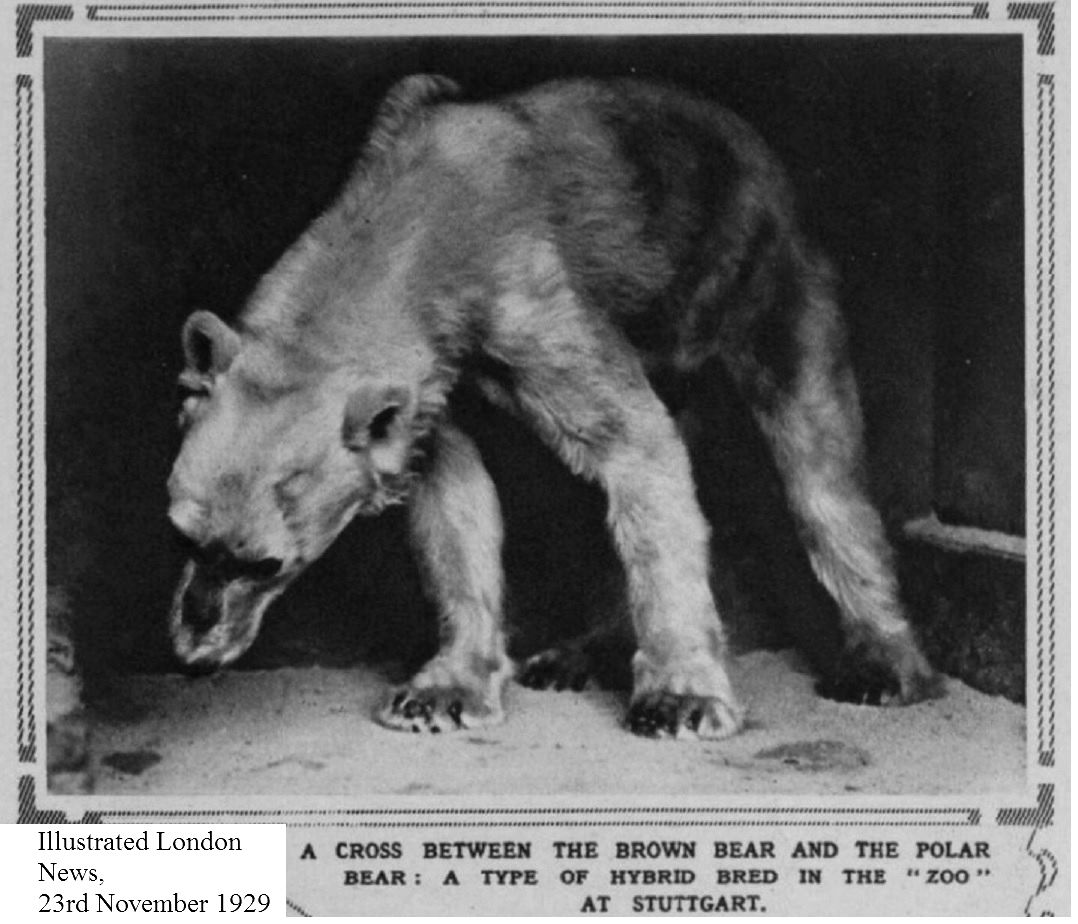
HYBRID BEARS (The Field, 30th June 1906) For some years past the pretty little zoological garden at Stuttgart has been noted for a race of hybrids between the Polar bear and the common brown bear of Europe. According to a recent Guide the founders of the race were a Polar bear purchased over thirty years ago and a brown bear born in the menagerie. The Polar bear was obtained by von Heuglin's expedition. These were put into a bear-pit In 1875, with the result that hybrids were produced, lighter in colour than the dam, but showing resemblance in shape to the sire as they grew up. One of the female hybrids was mated with the Polar bear in 1877 and had two white cubs, which unfortunately died in a few days, and the same result followed a similar birth In 1580. In December, 1881, there was another litter of two, of which one was killed by the dam. The survivor, a male, at a year old was quite white. Two hybrids bred at Stuttgart are now in the Zoological Gardens. One is a half-blood female, born in December 1893, and the other, a female, born in December, 1897, her cub by a Polar bear. The dam resembles a brown bear in colour, with lighter markings, and darker along the back and feet, intermediate in shape between the two species. The younger hybrid has nearly the form and colour of the Polar bear except for a light brown shade along the back. These animals have been placed in dens near the Polar bears, so that comparison between the parent species and the hybrids is rendered easy.
HYBRID BEARS (The Field, 27th April 1907) Hybrids between different species of rarely, if ever, occur in a state of nature, owing to limits of distribution, and their production in menageries is not often attempted, owing to the difficulty of keeping different species in one den. In some cases the difficulty has been got over by putting the animals together at an early age, the most successful instance being that of Herr Adolf of the Stuttgart Garden, who for nearly thirty years bred hybrids from a Polar sire and brown bear dam, the offspring being fertile inter se. The garden was closed and the stock sold last year, when the Hon. Waite Rothschild purchased and deposited in the Zoological Gardens the oldest two of these hybrids. At the scientific meeting of the society on Tuesday evening Mr Henry Scherren read a paper on the subject, giving a short account of the Stuttgart hybrids. Other cases mentioned are the birth of cubs in Regent’s Park in 1859, the dam being a European brown bear and the sire an American black bear. Cases of hybridity between the brown bear and the grizzly bear recorded in Der Zoologische Garten as having occurred in the gardens at Cologne and Hanover are referred to, but the author had ascertained, by the courtesy of the directors, that there was no official record of the births. The last case mentioned was that at Halle-an-der-Saale, where on Jan. 23, 1907, three cubs were born, the sire being a Polar bear and the dam a brown bear. The animals had been kept together for some years, and there seemed to be little doubt that this was the third lot of cubs, and that the other two were eaten by the dam. In the same garden Dr Brandes, the director, has had for more than a year a female Korean black bear in the same den with a pair of sloth bears. The animals agree very well, but so far there has been no signs of mating.
THE SMITHSONIAN’s HYBRID POLAR BEARS (USA)
In his book, "Wild Animals In and Out of the Zoo" (1930, Smithsonian Institution), Dr. William Mann, director of the Smithsonian’s National Zoo between 1925 and 1956, listed twenty-one different species or subspecies of bears (170 individual bears total) held by the Smithsonian Zoo’s Rock Creek Park "Bear Row" since 1890. Most of these are now reduced to subspecies. For example, the Kodiak bear (Ursus arctos middendorffi) is also known as the Alaskan brown bear, but at the time when the hybrids were born in the National Zoo, these were considered separate species. Brown bear cubs often retain a white ring around the neck for the first few years of life.
The low survival rate of cubs at the time is also not unexpected; northern-living bears generally give birth during the hibernation period which means the mother remains drowsy and the den is undisturbed for some months. In captivity the bears were not hibernating when the cubs were born and the mother may kill the newborns, either accidentally or deliberately because of disturbances. This was one reason for hand-rearing cubs (another reason was to make them handleable).
In the early 1930s, when zookeepers noticed that male polar bear, Snowy, and female Kodiak bear, Ramona, were friendly towards each other so they were placed in the same enclosure along with a female polar bear called Marion. Keepers did not believe the species could interbreed so they were surprised when Ramona produced two cubs in February 1935. One cub lived fifteen days and the other died a few days later.
The Menasha Record, 1st May 1935 belatedly reported "Zoo Hybrid Bear Curiosity. An interesting hybrid animal one so rare that heretofore scientists have believed it couldn’t be produced, is the subject of attention and conjecture on the part of authorities at the national zoo in Washington. It is a bear cub, the offspring of a female Alaskan brown bear and a polar bear. Such a hybrid is unusual because the parents not only represent different species but belong to different genera." (They are now classified as both belonging to genus Ursus.)

"Cubs make their bow to the world during the Winter, but not even the keepers see the little fellows until Spring, as they are in the caves with their mothers. One can always tell if everything is going well, for little contented sounds can be heard from the top of the cave where there is a trap-door used for ventilating. This year would have been especially interesting along "Bear avenue" had the Grim Reaper chosen to pass by. The Kodiak-Polar hybrid died, much to the regret of every naturalist. This death was not due to lack of care on the part of the Zoo, inasmuch as it ls impossible to reach a mother without causing her to turn into a raging beast at the sight of even her closest man-friend, and in such a condition, the young could suffer serious injury and often death. It is ‘just one of those unfortunate affairs of natural history’ that we shall not be able to see this interesting cub." (Spring Comes to the Zoo, Washington Evening Star, 19th May, 1935.)
Ramona and her cubs were moved to a separate enclosure and Snowy apparently became irritable. Snowy and Ramona were reunited after the cubs died and keepers and zoologists watched to see what would happen. It turned out that Snowy preferred to mate with Ramona than with polar bear female Marion.
Ramona became pregnant again and was moved to an individual den where, in February 1936, she gave birth to four cubs. With better husbandry, three of her four yellowish-white cubs survived: males Taku and Fridgee, and female Pokodiak. These three grew to adulthood. Snowy and Ramona were reunited after two and a half years apart. And male hybrid, Willie (named after Dr. Mann), was born in 1939 (Marion, the female polar bear, was moved to a separate enclosure.) According to Dr. William Mann, 23 Kodiak x Polar bear cubs were born during the following 20 years, though only 4 lived to adulthood.
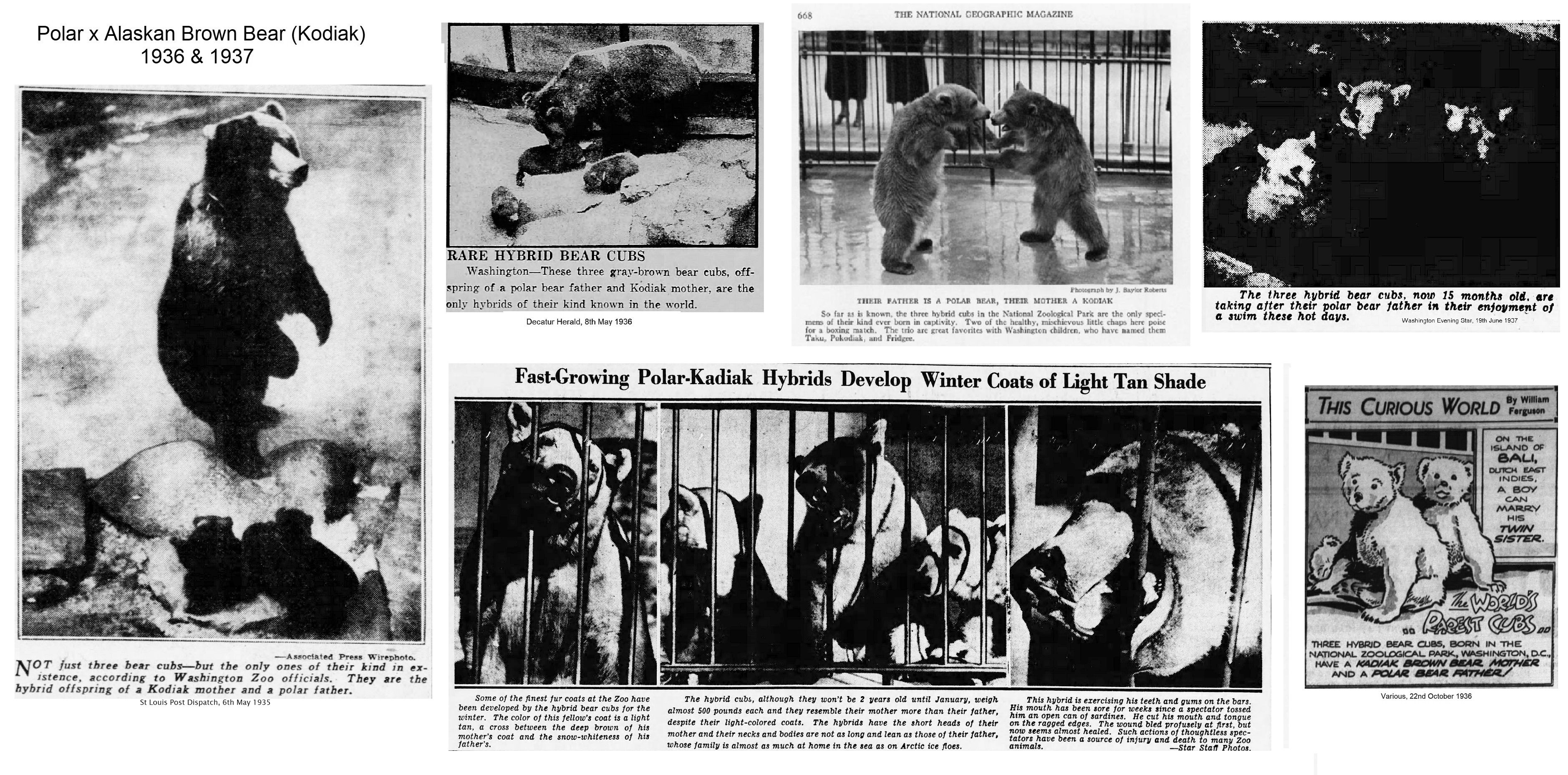
The Decatur Herald, 20th February 1935 described the birth of the hybrids, but the parents’ names are different: "Hybrid Bear Cubs Born to Polar ad Brown Pair in Zoo. Washington. The scientific world, still agog over the Dilonne quintuplet affair, had a new shock from the animal kingdom yesterday. Two bears in the national zoo, a female Alaskan brown bear and a polar bear, handed their keepers ,and biologists a surprise in the form of cubs–or at least a cub–something that the scientists didn’t believe could happen until yesterday. The parents are at opposite ends of the bear family. Whether there is one new cub or twins is still uncertain because keepers have not yet entered the den for fear of exciting the mother. The proud papa is ‘Snow,’ a pure-white polar bear. He was revelling in a touch of colder weather that arrived in Washington yesterday morning. The mother is ‘Totem Pole.’ Both have lived at the zoo for about five years. The parents are not only different species, but different genera, which makes them even more unrelated. Dr. William M. Mann, director of the zoo, plans to make every effort to save the babies, which may be difficult because hybrids seldom live long. The only hope of the cubs for life at present Is that their mother may be giving them needed care."
There was an account of the bears in "Remembering a time when things got a little freaky at the National Zoo" by John Kelly (Washington Post, 6th March, 2020). This noted that Snowy, the father, had come from the Edinburgh Zoo, and Ramona, a female Kodiak bear came from Alaska. The female polar bear was referred to as Snowy’s "other wife," as the newspapers put it. One hybrid cub lived 15 days before it was found outside the den, frozen to death. The other disappeared and was believed to have been eaten by Ramona, who was "nervous and irritable at her first [maternal] experience," according to The Washington Post. When Ramona produce four mor hybrid cubs, the Evening Star reported "Cubs with a brown bear for a mother and a polar bear for a father would undoubtedly be a great drawing card at the zoo," something not lost on zoo director William M. Mann. Dubbed the "three little Whatsit bears" by one paper, there was a contest to name them and when the three surviving were robust enough to be exhibited in May 1936 they made their debut in front of an eager crowd of reporters. According to Mann "Right now I’d say all three of them look more like brown bears than polars, but there’s still no telling which they will resemble when they grow up." When the 2nd generation was born in 1950 it was an event so unexpected that Gene’s photo appeared on the cover of the Journal of Heredity and more than 30,000 Washingtonians went to the zoo when he made his public debut.

The Baltimore Evening Sun, 7th August 1957 (Pg 22), among others, tells us "An Alaskan brown bear and a white polar bear are "papa" and "mama" in the National Zoological Park here. They have two hybrid offspring.
On September 29th, 1959, various papers, including the Herald News, Passaic, New Jersey (Pg 8) reported "Some years back the National Zoo confounded genetics authorities when it unwittingly bred an Alaskan brown bear to a polar bear. More than 20 hybrid bears were born over a stretch of two decades."
Staff assumed the hybrids would be sterile, but in 1949 Pokodiak became pregnant by her younger brother, Willie. Dr. William Mann considered this as unusual as two mules producing offspring (Washington Post, January 8, 1949). In 1950 Pokodiak gave birth to a litter of 6 cubs, though only a single male survived. The low survival rate isn’t surprising because bears normally produce 2 – 3 cubs in a litter, so the 6 cubs would have been smaller and the mother would not have produced enough milk for all 6.
"VISITORS–Maybe it is unkind to switch suddenly from. The Congress to the zoo but our Washington Zoo boss, William A. Mann, continues to try to steal attention away from his rival attraction up on Capitol Hill . . . he has upset all precedent by having two supposedly sterile hybrid bears produce twin offspring. The parents are half Kodiak and half polar bears and are presumably as sterile as a couple of mules, but they have reversed all known rules and produced offspring–at least the good doctor believes they have, but can’t prove it because the cubs are being carefully guarded by their parents far back in their cave-like den." ("By the Way," Los Angeles Times, 8th January 1949)
Nothing more was heard of that litter, so if there were cubs they did not survive and Pokodiak became pregnant later in 1949 (gestation period would be 265 – 270 days). In January 1950, cubs were born to the pair and Dr. William Mann said "It shouldn’t have been born at all. It violates all the laws of zoology and biology, of Mendel and Darwin, of.… It violates the laws of everything." (Washington Post, January 27, 1950). The cubs were, of course, inbred, but that was not unusual for zoos at that time. The surviving cub was named Gene (as he was a genetic miracle) and he became quite an attraction. He was housed with another young bear and the two enjoyed wrestling and playing.
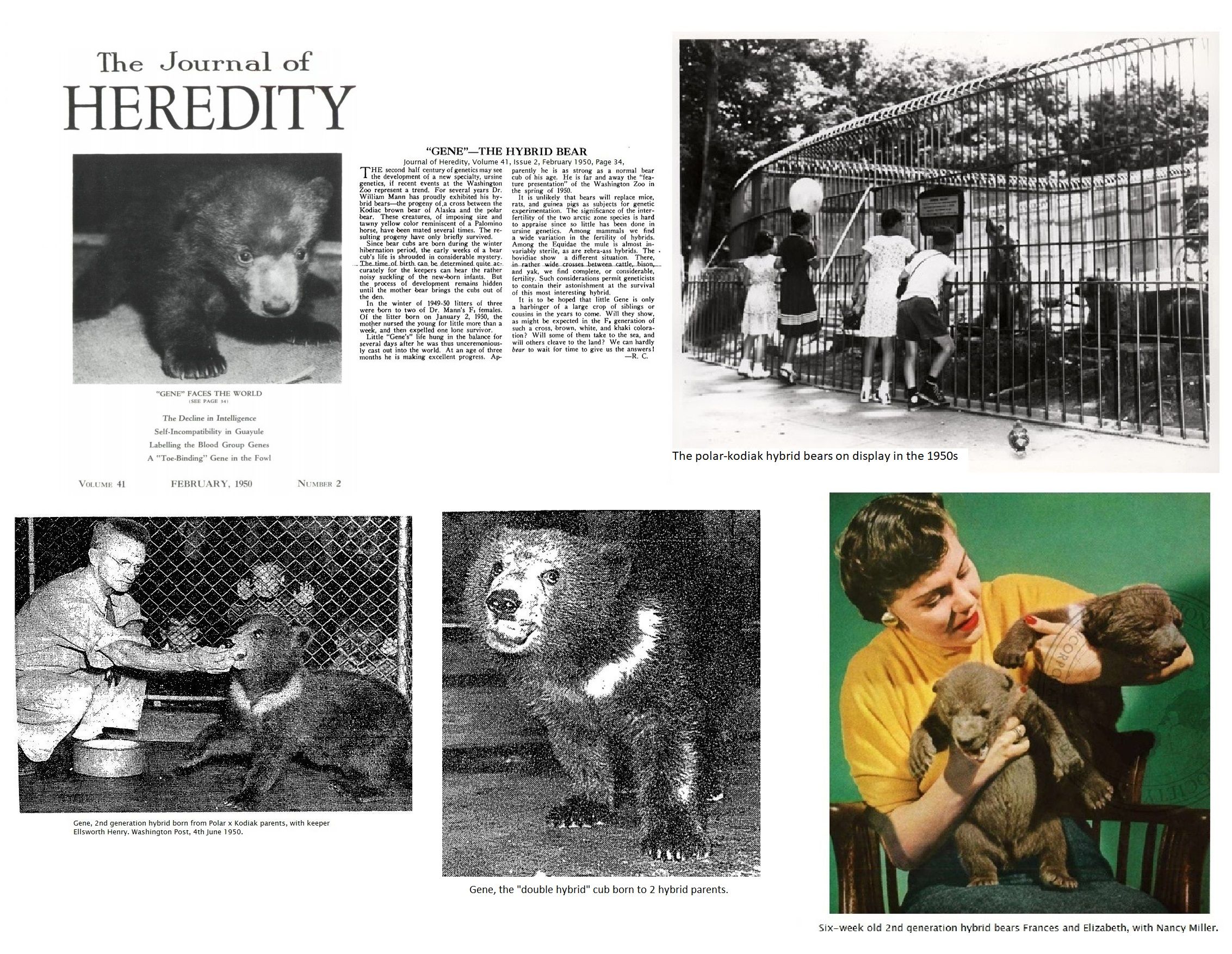
More 2nd generation hybrids arrived in 1952. "Hybrid Bears Die after Birth. All of the double-hybrid bear triplets born New Year’s at the Washington zoo are dead. They were second generation offspring of an Alaska brown bear and a polar bear. Their hybrid parents were rare and double-hybrids are rare still. Two of the triplets died earlier this week and the third Friday." (Fairbanks Daily News-Miner, 5th January 1952, among others)
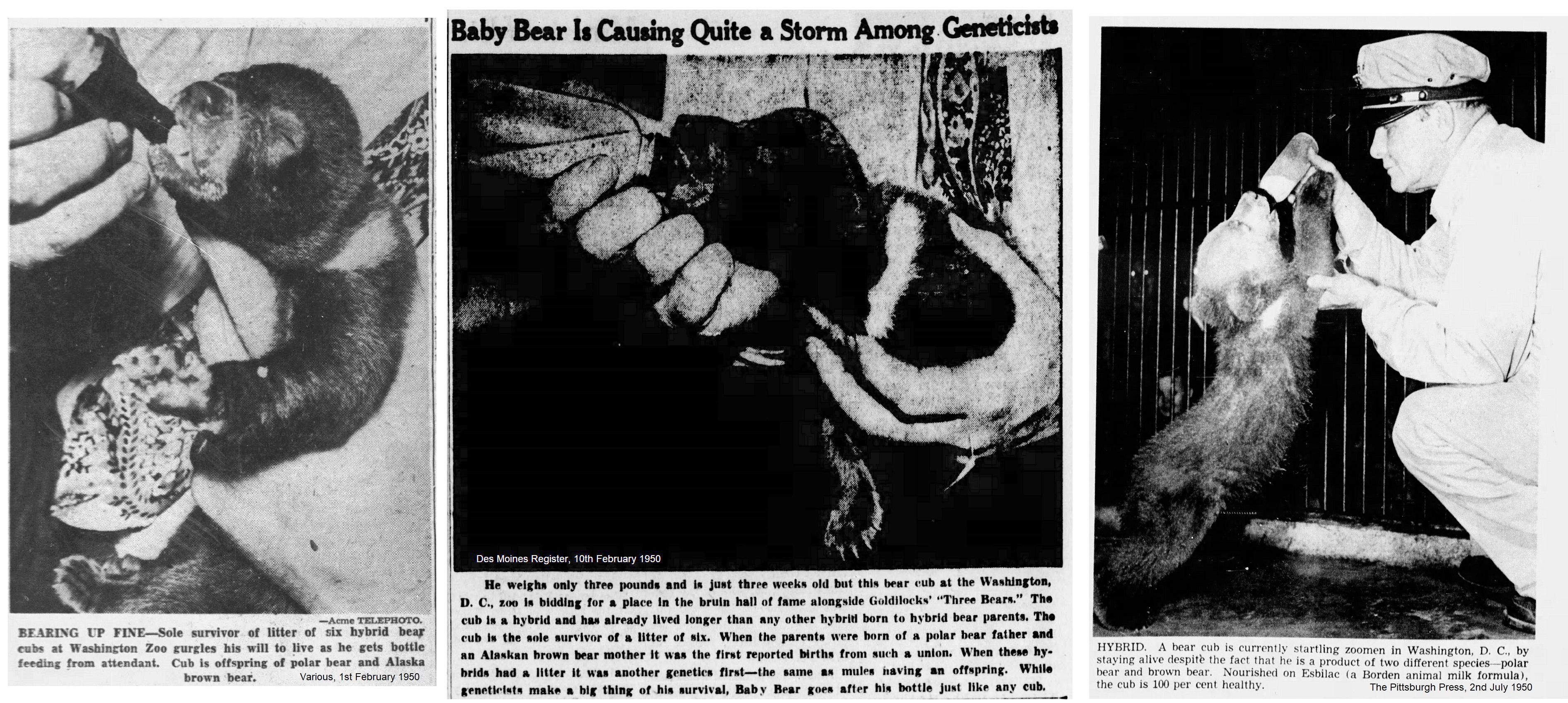
According to the Richmond Times Dispatch, 3rd January 1952 (pg 6): "Only one of double-hybrid bear triplets born on New Year’s Day in the Washington Zoo survived today. The tiny cub, tentatively dubbed "Brownie," was being kept alive on a diet of warm milk and baby food vitamins. It weighed just a pound at birth. Dr. William M. Mann, zoo director, said ‘Brownie’ and his – or her – older brother, a 100 pounder named ‘Gene,’ are the only double-hybrid bears known to exist. Two of the triplets succumbed less than 24 hours after birth, but zoo officials said ‘Brownie,’ whose sex has not yet been determined, showed a fair chance of living. Dr. Mann said double-hybrid bears are a freak of nature. By comparison, he said, they are like the offspring o mules – ‘and whoever heard of mules having offspring?’
The story of ‘Brownie’ begins about 20 years ago when a Polar Bear named ‘Snowy’ arrived at te local zoo from Scotland and set up a harem. Along in 1936, ‘Snowy’s’ roving eye was captured by an Alaskan brown bear named ‘Ramona,’ who became one of his favorite wives." Experts said nothing would come of it because they were different kinds of bear. The experts were wrong. ‘Snowy’ and ‘Ramona’ produced two litters of single-hybrid bears. Four of them are still loving, two males and two females. That was ‘Snowy’s’ contribution as a propagator of a family of genetic marvels."
A more twee report was in the Bradenton Herald, 2nd January 1952: "Double-Hybrid Bear Cubs At Washington Zoo. Once upon a New Year’s there were three little bears who weren’t supposed to be. Neither was their brother. Nor their mama and papa. Their uncle and their aunt too. But they all were. Their grandma and grandpa were supposed to be. Only they weren’t supposed to have babies because grandma was an Alaska brown bear and grandpa was a polar bear. But they had lots of them. Four are grown up and still living, the mama and papa and the uncle and aunt. They are hybrids (mules are hybrids, too) and are not supposed to have babies. But mama and papa did. First they had brother [Gene] and Tuesday, New Year’s they had the three little bears all at once. These are double-hybrids. Dr William M. Mann announced all this. He is director of the Washington Zoo, where it all happened beginning about 1936. The babies are being nursed with bottles and eyedroppers. People can visit them in two weeks if they live and start growing up. Of course, double-hybrids can’t have babies."
By 1959, the zoo had produce 20 first generation hybrids and was likely the source of performing hybrid bears. Between 1950 and 1976, fourteen second generation hybrids were born, although only two survived long term. First generation hybrid Pokodiak, the mother of the 2nd generation hybrids, died in 1974 aged 38 years old. In August 1987 Pokodiak and her hybrid offspring were mentioned in several US newspapers which reprinted a New York Times Science Q&A "What are the two most distantly related species that produced hybrid offspring? And which of the hybrids have produced fertile offspring?"
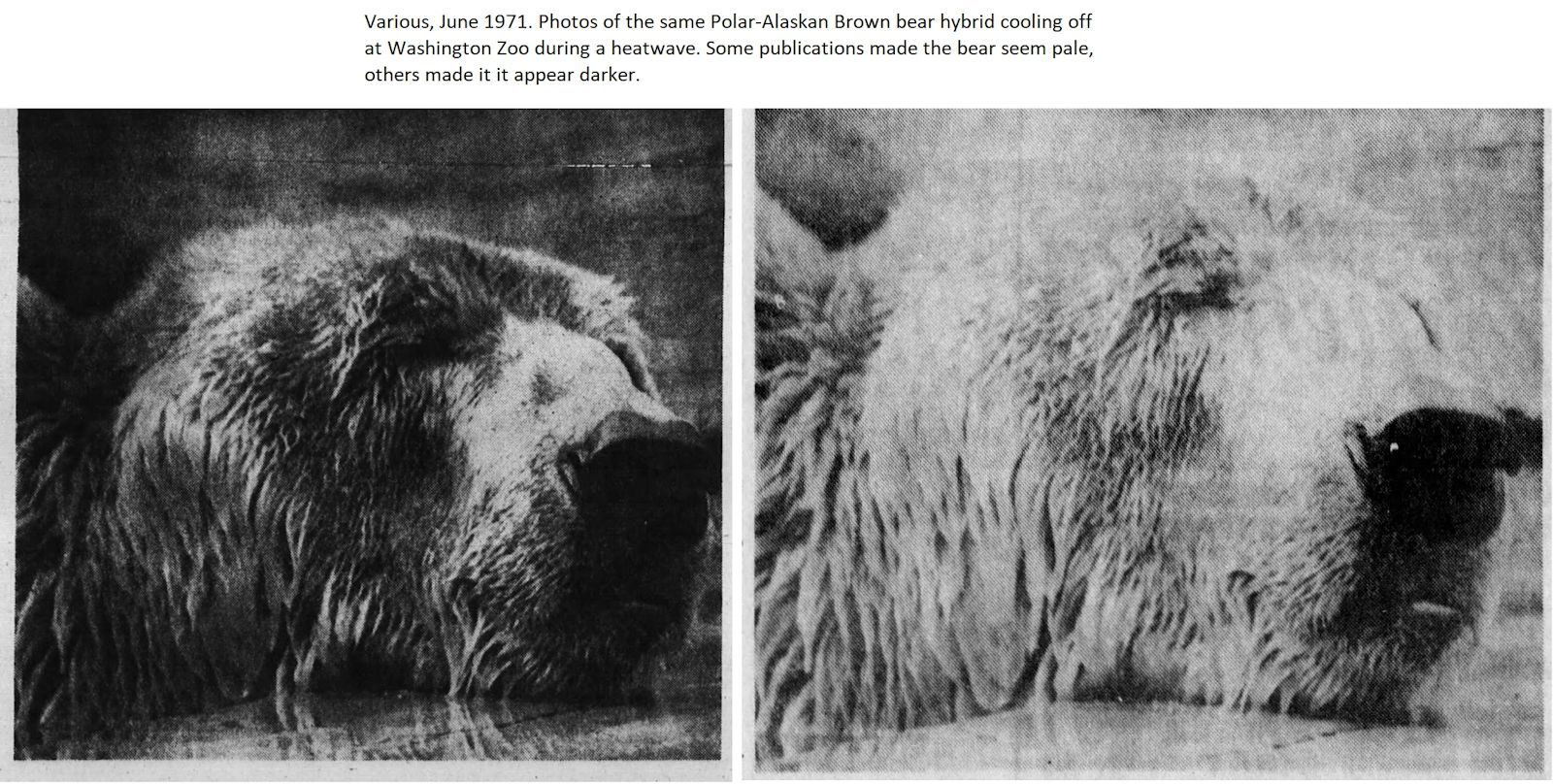
In the National Geographic (Vol 137:4, April 1970) article "White Tiger in My House", Elizabeth C Reed mentions being foster mother to 4 hybrid bear cubs from the National Zoological Park in Washington where her husband was director. The second generation hybrids were brown with some white markings. DNA studies have apparently suggested that some brown bears are more closely related to polar bears than they are to other brown bears, raising an interesting question as to whether they are truly separate species.
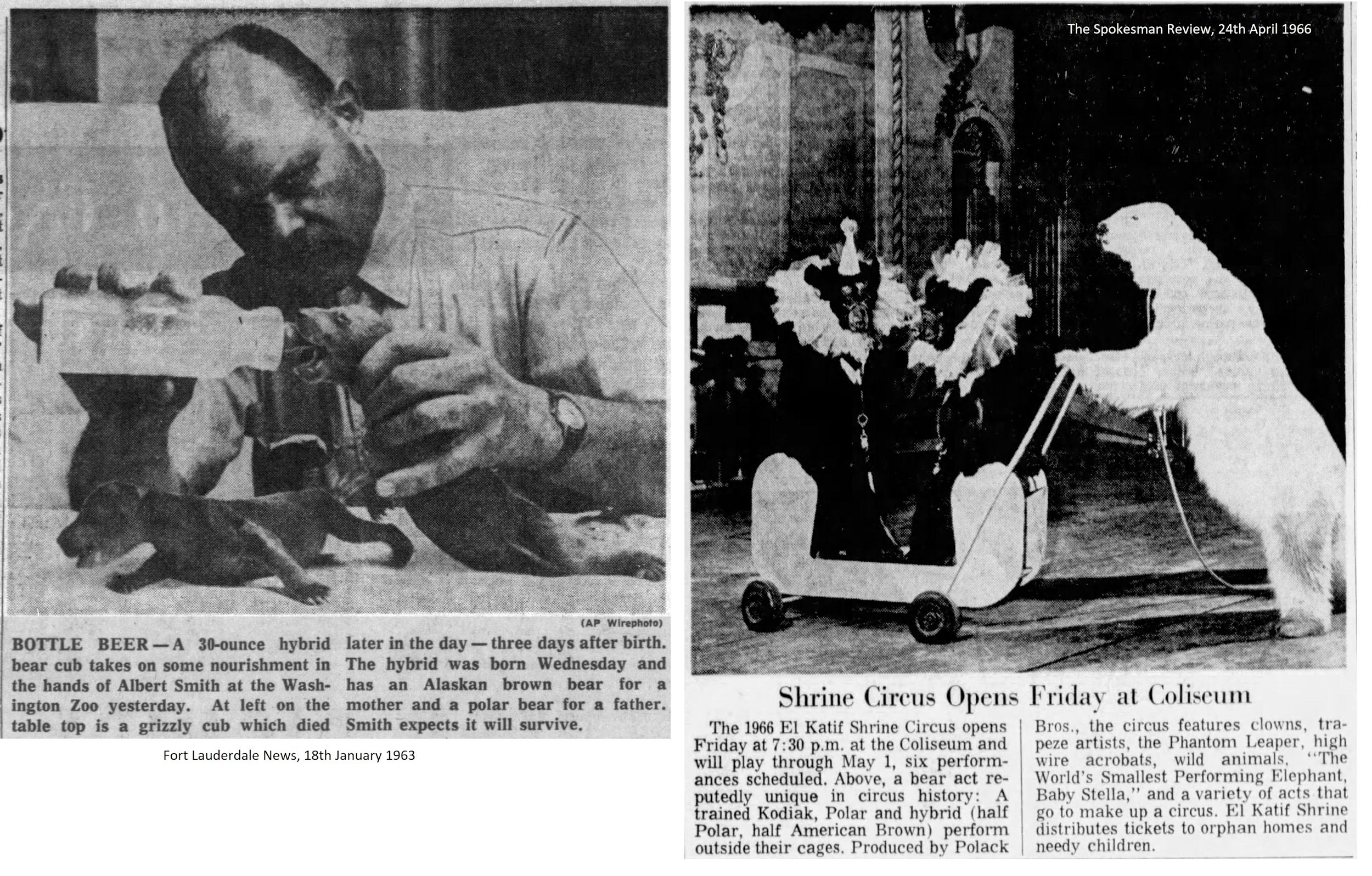
ELOISE BERCHTOLD’S PERFORMING POLAR BEAR HYBRIDS
In 1966, the El Katif Shrine Circus publicised a unique bear act – a Kodiak, Polar and hybrid bear trio performing outside their cage. (The Spokane Review, Washington, 24th April 1966). This circus claimed to have the only hybrid bear in existence: "1966 Shrine Circus Will Perform in Akron. Unusual bears . . . will be featured at the 1966 Shrine Circus April 11-15 at Akron Municipal Airport. The only trained Kodiak Bear in the world, the only Polar Bear trained to perform outside a cage, and the only Hybrid Bears in existence will perform at the commands of their trainer, Miss Eloise Berchtold." (Medina County Gazette, 30th March, 1966.) The Hawthorn corporation leased animals such as bears and big cats to the Shrine Circus, and claimed to have bred hybrid cubs at Mellody Zoo (Hawthorn-Mellody Farms & Amusement Park/ Hawthorn-Mellody Farms Dairy Zoo, Libertyville, Illinois (this was owned by John F. Cuneo Sr. between 1937 and 1967.) It is possible, as they had a polar bear named Zero.
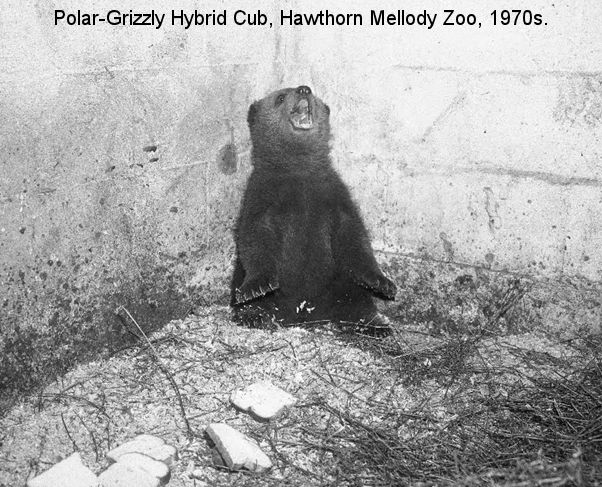
A picture of a one month old polar-grizzly hybrid cub, one of a number that Hawthorn bred. Later a Hawthorn act, presented by Eloise Berchtold had a couple of the hybrids in the act. Berchtold’s hybrids were performing in 1976, a short while before Berchtold was killed in the ring by an elephant. Berchtold’s hybrids had a large, thick grizzly-type conformation but were a palomino/yellow colour. Supposedly these were purchased from the National Zoo's stock.
THE LODZ ZOO HYBRIDS
On 3rd March,1961, the Guardian (London, UK) (Pg 14) reported "Hybrid Bear Cubs Born. Warsaw, March 2. A female brown bear in Lodz Zoo has produced a ‘big zoological sensation,’ two hybrid cubs whose father is a polar bear, the Polish News Agency said today. Reuters."
Instances of these hybrid bears reaching maturity and being fertile have been reported by (Kowalska 1969; Wurster-Hill & Bush, 1980). According to Zofia Kowalska (Scientific Assistant, Miejski Ogrod Zoologiczny w Lodzi, Lodz, Poland) in "A Note on Bear Hybrids: Thalarctos maritimus x Urus arctos", 4 sets of Polar bear x Brown bear hybrids were born at Lodz Zoo. The father was a Polar bear (Thalarctos maritimus) and the mother a Brown bear (Urus arctos).
This illustrates one aspect of Haldane's rule - the heterogamous sex (male in this case) being absent, rare or sterile; in this case more females were born and survived than males.
The parents had been housed together since 8 months old, were sexually mature at 64 months (5 years 4 months) and produced their first cubs at the age of 72 months (i.e. 6 years old). In the wild, male Polar bears do not reach sexual maturity until 8 years (Pederson, A, 1957; "Der Eisbär", Neue Brehm Büch. No 201: 1-64), but the Lodz Zoo's Polar bear impregnated the female when he was only 5 years old. Kowalska suggested the diet of captive Polar bears led to earlier sexual maturity.
Kowalska described the Lodz Zoo's hybris as all being much lighter in colour than the Brown bear while having the shape of the Polar bear. They all developed normally. A female hybrid from the 1961 litter mated with her Polar bear father in 1966 and on 20/12/1966 she produced a single male cub with nearly white fur. The other female from the 1961 litter was mated to a Brown bear in 1966 and on 19/12/1966 she produced 2 dark coloured male cubs, one having a light coloured head and neck. Kowalska submitted the report in June 1967 and it was published in 1969 continued to monitor these 2nd generation hybrids and was particularly interested in their fertility.
CLINTON HART MERRIAM’S "HYBRID"
Clinton Hart Merriam, taxonomist of grizzly bears, came across one bear that was significantly different from other grizzlies. Believing it to be a living fossil, he named it Vetularctos inopinatus ("ancient, unexpected bear") in 1918. The nearly full-grown female bear had been killed by 2 Inuit hunters in 1864 at Rendezvous Lake, Barren Grounds, Canada and its skull and enormous yellowish skin acquired by naturalist Robert MacFarlane (leading to its popular name of MacFarlane's Bear). MacFarlane shipped these to the Smithsonian Institute where they remained forgotten in a store-room until Merriam rediscovered them. Although MacFarlane's speciment was only belatedly recognised as unusual, the Inuit had, and still have, stories about strange-looking bears.
Merriam described it as "buffy whitish" with a golden brown muzzle and suggested it came from a separate lineage to the Ursinae, being a modern descendent of the extinct giant short-faced bear and relative of the modern spectacled bears. The oddly shaped skull and teeth differ from that of both the Grizzly and the Polar bear, indicating it is not merely a colour morph of either species (blonde brown bears are known and some captive Polar bears take on a yellowish hue). Today it is variously considered a natural hybrid between a grizzly bear and polar bear or an aberrant form of grizzly, although DNA studies and morphological analysis of the skull have not been carried out. A similar bear was reported from Kodiak Island. The confirmation, in 2006, of a hybrid occurring in the wild led to renewed interest in MacFarlane's specimen.
OTHER POLAR BEAR HYBRIDS IN BRIEF
In 1943, Clara Helgason described a bear seen during her childhood: hunters had shot a large, off-white bear with hair all over his paws. Some believed it to be a polar bear that had wandered far from its known range; others claimed it to be an albino Kodiak bear. The presence of hair on the bottom of the feet suggests it was not a Kodiak brown bear and it may have been a natural hybrid.
The Santa Maria Times, 20th November 1986 (Pg 7) reported a hybrid bear owned by Australian Dennis Williams and his wife, Jenny, the proprietors of African Safari Village, a travelling zoo of exotic and non-exotic animals. The African Safari Zoo was on a 3 day visit (21 – 23 November 1986) outside JCPenney. Although the hybrid bear’s parents were not stated, they were probably brown bear x polar bear based on this statement: "Lenny, a hybrid bear with our zoo, came from Hollywood . . . he had been dyed white to look like a polar bear." (Lenny had been de-clawed, his teeth had been removed and his previous owners said he couldn’t be handled, though in five years with the Williams he had shown no signs of aggression.)
March 2017: A hybrid bear has been shot dead after escaping its enclosure at a northern German zoo. The bear was shot by Zoo Osnabruck personnel . . . Andreas Busemann [zoo head] said the bear, called Taps, was one of the zoo's favourite attractions - a so-called cappuccino bear bred from polar bear and brown bear parents. He said it was not clear how the animal had managed to escape from the compound, but that police were investigating. The zoo has since posted a tribute to Taps on its Facebook page. "Today was a sad day... We mourn the passing of one of our favorite zoo residents," the post read. (9News)
2021. A census of captive polar bears in China noted: "it is certain that some of the bears listed in China are brown bear / polar bear hybrids" and listed the following: Shanghai Haichang Ocean Park - name and sex unknown, likely hybrid polar bear / brown bear; Hangzhou Polar Ocean Park - Babe (female; probable hybrid polar / brown bear).
POLAR X BROWN BEAR HYBRIDS IN THE WILD
Natural polar/grizzly hybrids have been dubbed "pizzly", "grolar" or "polargrizz" bears. The Canadian government suggested the name "Nanulak", taken from the Inuit Nanuk (polar bear) and Aklak (grizzly bear). Taxonomists suggest "Ursus maritimus horribilis", "Ursus maritimus x horribilis" or "Ursus hibrada maritimus horribilis". Where bear populations have been reduced or where human encroachment on habitat forces the two species into closer proximity, such hybrids appear to be becoming more common. Grizzly bears have been sighted in polar bear territory in the Western Arctic near the Beaufort Sea, Banks Island, Victoria Island and Melville Island. A "light chocolate colored" bear, possibly a hybrid (although Grizzly bears can have colour variants) was reportedly seen with polar bears near Kugluktuk in western Nunavut.

In 2006, on Banks Island, 2000 km north of Edmonton, Canada, a sports hunter from Idaho shot a male hybrid grizzly/polar bear. At first, Martell and his Inuit guides thought the animal was a polar bear, but closer inspection reveraled the features of a grizzly bear as well. The bear had thick, creamy white fur typical of a polar bear, but had the long claws, humped back and concave face of a grizzly bear. It's eyes were surrounded with rings of black fur and it had small brown patches of fur on its nose, back and one paw. The bear was one from a population at Sachs Harbour. The polar bear is a descendent of the grizzly bear (the grizzly is variable in colour and the palest bears would have had a survival advantage on the ice). A lab analysis of the DNA confirmed it was a hybrid. Analysis of mitochondrial DNA showed the mother to have been a polar bear and the father to have been a grizzly bear. With polar bears endangered, it is sad that $50,000 allows a trophy-hunter to kill one of these beasts. Other unusually coloured "polar" bears have been seen in the region and may also be hybrids. Polar bears normally give birth to two cubs and it is possible the shot hybrid has a sibling.
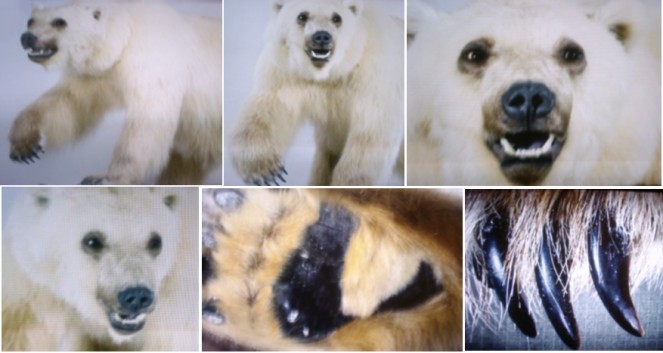
Inuvialuit hunter David Kuptana shot another hybrid on April 8th 2010 on sea after it scavenged through unoccupied cabins near Ulukhaktok (formerly Holman), NWT, on Victoria Island then approached the community. This is almost the same latitude and far from the mainland as the 2006 hybrid which was shot on adjacent Banks island. This second hybrid had creamy-white fur, typical of a polar bear, but had a larger head, long claws on the front feet and a ring of brown hair around its hind feet which suggested a grizzly bear. The head and ears had similarities to a grizzly bear. Wildlife DNA analysis showed it was a second-generation hybrid - the result of a female grizzly-polar hybrid mating with a male grizzly bear. This is the first time a second generation hybrid has been confirmed in the wild and means there is at least one female polar-grizzly hybrid near Banks Island. Further test will determine whether this bear was related to the male hybrid shot in 2006. The pelt was auctioned.
Polar/Grizzly bear hybrids will become increasingly common due to the absence of summer Arctic sea ice. Polar bears stranded on land will come into more contact with grizzly bears (or with other arctic brown bears such as the Kodiak or the Siberian Kamchatka bear). This has also allowed/caused interbreeding between harp seals and hooded seals and between beluga whales and narwhal. Interbreeding can be an evolutionary "shortcut" helping species adapt to major environmental changes. As well as speciation (divergence of one species into two or more), some related species can interbreed and converge. A cycle of divergence/convergence is found in Galapagos finches and is related to local environmental changes.
STUDIES OF WILD AND CAPTIVE POLAR BEAR HYBRIDS
In October 2009, a detailed study of captive-bred Polar x Grizzly hybrids by Alexandra Preuß (University of Osnabruck), Dr Ute Magiera (Osnabruck Zoo) and colleagues was published in the scientific journal Der Zoologische Garten. With only one verified hybrid seen in the wild, the study looked at 2 captive-bred hybrids out of the 17 hybrids known to exist in captivity. A few hybrid bears exist in zoos in the Czech Republic, Israel, Russia, Spain, Poland and Germany as a result of grizzly bears (a subspecies of brown bear) and polar bears being housed together. A study of hybrids born at Osnabruck Zoo, Germany confirms some of the previous observations regarding colouration and structure of the feet. It noted that hybrids inherited some distinct characteristics from either parent and some characteristics that were intermediate.
At Osnabruck Zoo, Germany, a male polar bear and female brown bear had been housed together since 1980, but not produced any cubs. After 24 years together, in January 2004, the female brown bear gave birth to two brown/polar bear hybrids, much to the surprise of Dr Ute Magiera, the zoo's conservation coordinator. Soon after their birth, the two hybrids were moved to another zoo, preventing them from learning any behaviours from either parent. The male was sterilised, but the female may prove fertile. When adult, the hybrids were intermediate in size between the larger polar bear and the slightly smaller grizzly. They had the longer necks of polar bears, but small shoulder humps reminiscent of brown bears. The size and shape of their heads was intermediate between the thicker-set brown bear and the more slender-headed polar bear. They had visible tails, like polar bears (those of brown bears are almost invisible). The soles of their feet were partially covered in hair; polar bear feet are fully covered in insulating hair while brown bears have hairless soles with the toes clearly visible. A polar bear has hollow hair-shafts while the brown bear has solid hairs or hairs with small hollow regions. The hybrids' hair was intermediate having hollow pockets. The male hybrid had solid hair on its paws, but the dark hair on its back had hollow pockets. The female's hair had a range of hollow regions. Having been separated from their parents, the cubs were not able to learn any behaviours from them. Their innate behaviour was similar to that of the polar bear. They used their front legs to stamp on large toys, much as polar bears stamp on ice to break into seal dens. They used their teeth to fling jute bages from side to side, just as polar bears fling prey around. In contrast, brown bears did not show this behaviour when playing with similar bags. Like polar pears, the hybrids lay down on their stomachs with hind legs spraddled (like a frog) when resting.
Researchers have found that the female ancestor of all living polar bears was an Irish brown bear prior to the peak of the last ice age, 20,000 to 50,000 years ago. Beth Shapiro, the Shaffer Associate Professor of Biology at Penn State University and Daniel Bradley of Trinity College Dublin, published a study in the journal "Current Biology" in July 2011. Climate changes affecting the North Atlantic ice sheet probably gave rise to periodic overlaps in bear habitats resulting in interbreeding. Maternal DNA from brown bears entered the gene pool of polar bears. Although the two species are very different in terms of size, color, conformation, fur type, dentition, behaviour and preferred habitat, Shapiro stated "We know that the two species have interbred opportunistically and probably on many occasions during the last 100,000 years [...] previous research has indicated that the brown bear contributed genetic material to the polar bear's mitochondrial lineage - the maternal part of the genome, or the DNA that is passed exclusively from mothers to offspring. But, until now, it was unclear just when modern polar bears acquired their mitochondrial genome in its present form".
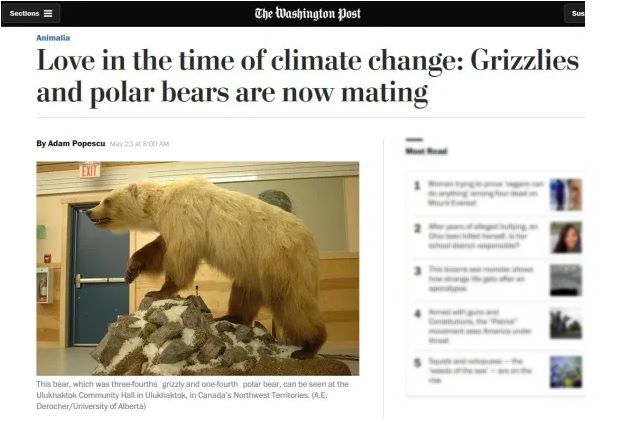
Adam Popescu wrote in "Love in the Time of Climate Change, Grizzlies and Polar Bears are Now Mating" in The Washington Post in 2016. "As the Arctic warms, sea ice is shrinking and the tundra is expanding. And the bears’ disparate populations are meeting, mating and creating a new breed that’s capable of reproducing . . . It’s called flexible mate choice: The bears are mating with the best possible partners as opposed to not mating at all, and they’re mating because they share relatively close territories and the same branches of the same evolutionary tree."
By 2019, DNA testing near Sachs Harbour on Banks Island in the Canadian Arctic and identified 8 confirmed hybrids in the wild, all descendants of the same female polar bear who had mated with two different male grizzly bears. It’s now known that the two species interbreed intermittently when climate forces their territories to overlap, but the hybrids seem to be absorbed into the mother’s species (as they remain with her for over a year) and do not breed to each other (introgression). A second generation hybrid is stuffed and on display at the Ulukhaktok Airport in the North West Territories.
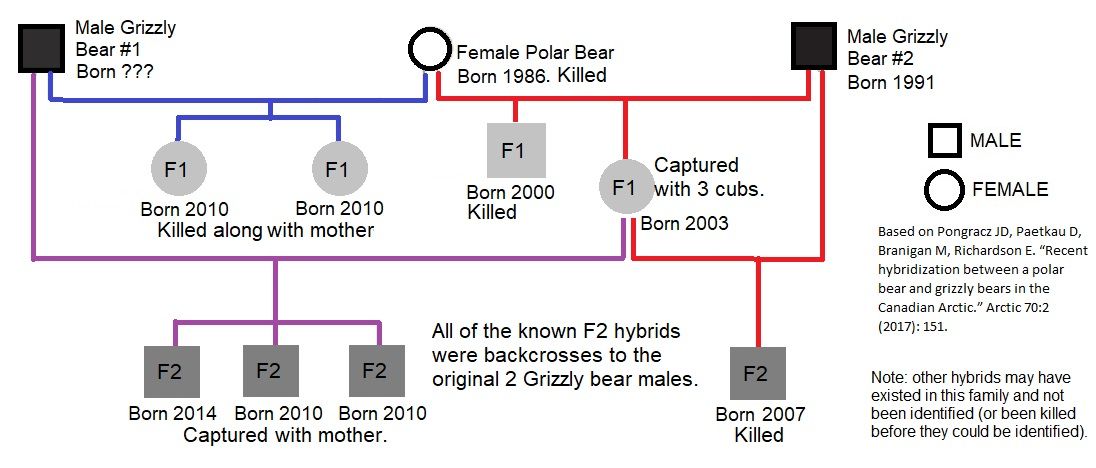
Pongracz et al found that Grizzly bears had become more common on the Arctic Islands in the Inuvialuit Settlement Region as the environment changed. Since 2007, grizzly bear – polar bear hybrids had been confirmed in that region. The researchers observed hybrids and used genetic analysis and parentage analysis to identify four first-generation (F1) hybrids and four backcross offspring of F1 hybrids to grizzly bears. The eight hybrid individuals traced to a single female polar bear who mated with two different grizzly bears. The same 2 males mated with their hybrid daughters to produce the F2 hybrids. The original female polar bear and three of her known F1 offspring, had been killed
ADMIRALTY (KOOTZNOOWOO), BARANOF (SHEE), AND CHICHAGOF (SHEE KAAX) HYBRID POLAR X BROWN BEARS
In 2021 Animal Planet aired a documentary about a colossal brown bear known as “Grandfather” lives on the island of Kootznoowoo (Admiralty Island), Angoon, Alaska which has a very high population of brown bears. When 18th century Russian fur traders that were based in Kodiak – also famous for massive bears – sailed past Kootznoowoo they saw the huge bears patrolling the coastline and they refused to leave their ships. They named the island “Fear Island.” As far as the Tlingit people know, no-one has been on the island for about 400 years. Grandfather is around 7ft. to the hump and some 13-14ft tall standing. Because Animal Planet has aired several fake documentaries, many people doubted this documentary’s authenticity. It was edited to compress the timescale and make it exciting and entertaining for viewers. Unedited research is methodical and, frankly, rather slow and dull with occasional exciting moments.
A researcher, a sceptic and a Tlingit tracker sought out an exceptionally large Kootznoowoo brown bear (aka Sitka brown bear) to find out whether it was descended from grizzly x polar bear hybrids isolated on the island for 11,000 years, or from brown bear x short-faced bear hybrid. The short-face bear is an extinct Pleistocene bear. DNA studies were carried out at the University of New York, in Buffalo, by Dr. Charlotte Lindqvist, America’s leading bear geneticist. DNA studies of hair samples showed the Kootznoowoo bears to be a distinct population descended from Brown bear and Polar Bear hybrids. There was, unsurprisingly, no link to the short-faced bear.
Regarding Grandfather’s exceptional size, scientists have conducted many genetic studies on neighbouring Kodiak bears which can grow to more than double the size of the average mainland brown bear due to a rich diet and an abundance of salmon. Kamchatka brown bears also reach huge sizes due to a rich diet. These bear population are not separate species, nor even a separate sub-species in terms of DNA divergence.
“ABC Islands” is the colloquial name for the Alaskan islands of Admiralty (Kootznoowoo), Baranof (Shee), and Chichagof (Shee Kaax), part of the Alexander Archipelago. The ABC Islands brown bear (Ursus arctos sitkensis) is a population of brown bear that resides on those islands and has a unique genetic structure that shows evidence of shared ancestry with polar bears. The bears are commonly a milk-chocolate colour but can range from blonde to black. The ABC Islands brown bears
At the end of the last ice age, about 11,500 years ago, a population of polar bears was stranded by the receding ice on these islands. Male brown bears swam across to the islands from the Alaskan mainland and mated with female polar bears. The islands’ bears are the descendants of a polar bear population that was gradually converted into brown bears by mating with male brown bears. There is clear evidence for gene flow from polar bears into ABC Islands brown bears but no evidence of gene flow from brown bears into the general polar bear population; polar bears contributed <1% of the autosomal genome (the chromosomes except X and Y), they contributed 6.5% of the X chromosome. The modern population of bears there are more closely related to female polar bears than to male polar bears.
Mixing of polar bears and brown bears occurs today in the Canadian Beaufort Sea (the part of the Arctic Ocean immediately north of Canada), where adult male brown bears wander onto the sea ice in late spring and sometimes mate with female polar bears. In areas such as western Hudson Bay and the Russian coast, diminishing sea ice means that polar bears are spending more time on land. At the end of the last ice age, polar bears may have become trapped on the ABC islands when sea ice was lost and sea levels rose. Meanwhile, young male brown bears tend to leave their birth area in search of new territory. Some may have crossed from the Alaskan mainland to the ABC Islands and hybridized with the stranded polar bears.
A genetic study of ABC Islands brown bears’ mitochondrial DNA, which is separate from the chromosomes and is inherited only from the mother found the mitochondrial DNA of ABC Islands brown bears to be closer to polar bears than to other brown bears. This meant the ABC islands bears descended from female polar bears.
Polar bears and brown bears diverged around 4 to 5 million years ago, but there were repeated episodes of interbreeding so that the final split was around 600,000 years ago. We are now entering another episode of hybridisation. A study of mitochondrial DNA from extinct Irish brown bears suggested that polar bears got their mitochondrial DNA from past hybridization with Irish bears, a recently extinct subspecies, so female Irish brown bears would have bred with male polar bears, probably due to human hunting and deforestation, and the descendants were transformed in to polar bears (the opposite direction to the ABC islands bears).
- Cahill JA, Green RE, Fulton TL, Stiller M, Jay F, et al. (2013) Genomic Evidence for Island Population Conversion Resolves Conflicting Theories of Polar Bear Evolution. PLOS Genetics 9(3): e1003345.

More information:
Asakura, S. 1969: A note on a bear hybrid, Melursus ursinus x Helarctos malayanus, at Tama Zoo, Tokyo. Int. Zoo Ybk. 9:88.
Cahill JA, Green RE, Fulton TL, Stiller M, Jay F, et al. (2013) Genomic Evidence for Island Population Conversion Resolves Conflicting Theories of Polar Bear Evolution. PLOS Genetics 9(3): e1003345.
Gray, A.P. 1972: Mammalian Hybrids. A Check-list with Bibliography. 2nd edition.
Kowalska, Z. 1962. "Intergeneric crossbreed of the brown bear Ursus arctos L., and the polar bear Thalarctos maritimus (Phipps)." Przeglad Zoologiczny, 6:230, 1 pl. [Polish with English summary.]
Kowalska, Z. 1965. "Cross breeding between a female European brown bear and a male polar bear in Lodz Zoo." Przeglad Zoologiczny, 9:313-319. [Polish with English summary.]
Kowalska, Z. 1969. "A note on bear hybrids Thalarctos maritimus and Ursus arctos at Lodz zoo." International Zoo Yearbook, 9:89.
Martin, P.L. 1876. "Ursus arctos and Ursus maritimus. On bastards between these species born in Nill's menagerie at Stuttgart." Zoologische Garten, 1876:20-22. [Zoologische Garten, 1877:135-136. W. Stendell and E. von Martens, tom. cit., pp.401-402.]
Martin, P.L. 1882. "On a hybrid between a male Ursus maritimus and a female Ursus arctos." Pederson, A, 1957; "Der Eisbär", Neue Brehm Büch. No 201: 1-64
Wurster-Hill, D.H. and Bush, M. 1980: The interrelationship of chromosome banding patterns in the giant panda (Ailuropoda melanoleuca), hybrid bear (Ursus middendorfi x Thalarctos maritimus), and other carnivores. Cytogenet. Cell Genet. 27:147-154.
Scherren, H.: Some notes on hybrid bears. Proc. Zool. Soc. London 431-435, 1907.
Alexandra Preuß, Udo Gansloßer, Günter Purschke and Ute Magiera. 2009: Bear-hybrids: behaviour and phenotype. Der Zoologische Garten Volume 78, Issue 4, 2009, Pages 204-220
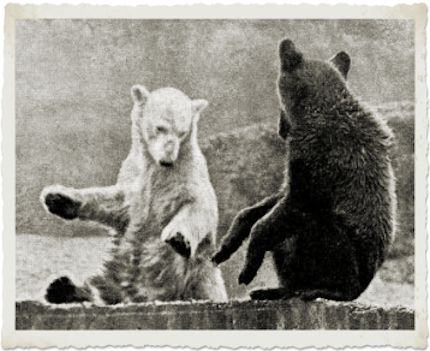
Some Notes on Hybrid Bears. By Henry Scherren, F.Z.S. Received April 9, 1907. (Proceedings. General Meetings for Scientific Business. Zoological Society of London. 1907, pp. 1-446. (January – April). Page 431)
The fact that some months ago the Hon. Walter Rothschild purchased from Stuttgart and deposited in the Society's Gardens two hybrid Bears attracted attention to these animals, and induced me to look into the literature on the subject. Bears play a considerable part in folk-lore; and one might have imagined there would be many references to cases of hybridity, seeing that these animals have been credited with carrying off women [he quotes a Latin story of bear carrying off young women]. Similar stories have been told from remote antiquity of the anthropoid apes, and among them cases of hybridity, though suspected, are not established. I am acquainted with no case of hybridity in Bears in a wild state, and with but few in zoological collections. Dr. Brandes has suggested that the absence of records of wild hybrids is due to the fact that the species occupy regions widely separated; and that the paucity of menagerie-bred hybrids may be accounted for by the fact that there is always the fear that putting two individuals in one cage may have bad results, since a fight between two adult bears is sure to terminate fatally for at least one of the combatants.
The first well-established case of hybridity in Bears appears to have occurred in the Society's Gardens between a Black Bear male {Ursus americanus) and a European Brown Bear female (U. arctos) [* A. D. Bartlett, P. Z. S. 1860, p. 130.] Copulation was observed in May 1859, and on December 31st three cubs were born, "naked and blind and about the size of a full-grown rat." One cub was carried by the dam in her mouth for a day or two; and as it disappeared it was supposed that she devoured it. At the age of five weeks the surviving cubs (1 male, 1 female) were "as large as a common rabbit. Their eyes began to open by this time; they were covered with a short thick fur, and were nearly black." This last observation is of some value, as it supports those of other authorities with regard to the coloration of the hybrid cubs following that of the male. Mr. Bartlett did not give the duration of life, but reference to the Occurrence Book shows that they died on Feb. 14, 1860.
The next case occurred in the Zoological Garden, Cologne, the male parent being a European Brown Bear (U. arctos) and the female a Grizzly Bear (U. horribilis). Prof. H. Alexander Pagenstecher, of Heidelberg, visited the Gardens in Paris, Lyons, and Cologne, and the following passage occurs in his account of what he saw in the city last-named [* Zoologischer Gavteu,' 1867, pp. 287, 288.]:-
"Von Baubthieren haben wir namentlich noch den Barenzwinger, ausgezeichnet durch die jungen Bastarde vom gewohnlichen braunen Baeren und der grauen Baerin, welche in dem weiten Kafige trotz ihres gewaltigen Korpers mit solcher Schnelligkeit umherrannte, dass man von der eminenten Gefahrlichkeit des Thieres in der Freiheit eine genligende Vorstellung zu erlangen vermochte."
["From Baubthier we have the bear kennel, distinguished by the young hybrids of the male common brown bear and the female gray bear which, in spite of their enormous size, ran around in the wide cage with such rapidity that one was able to get a satisfactory idea of the eminent danger of the animal in the wild."]
There seems to be no doubt about the event, but particulars were not entered at the time in the records of the Garden. Dr. Wunderlich, in reply to my enquiries, regretted that he could add nothing to the foregoing account, and informed me that no one now in the Garden remembered the hybrids.
Hanover Zoological Garden is said to have been the scene of the third case, about which, however, some doubt exists. Dr. Theodore Kottnerus-Meyer, writing on Mammalian Hybrids [* Zoologischer Garten,' 1904-, p. 61.] says: –
"In den achtziger Jahren .... besass der Hannoversche Garten auch eine Grislybaerin (U. Ferox) die in giiicklichster Ehe mit einem Braunbaren ( U. arctos) lebte, unci wiederholt von ihm mit Erfolg gedeckt wurde. Die Jungen glichen dem Vater und hatten ganz den Typns des Braunbaren."
["In the eighties ... the Hannover Zoological Garde also owned a female Grizzly bear (U. Ferox) who lived in the happiest marriage with a male brown bear (U. arctos) and was repeatedly covered by him with success. The young were like the father and completely had the type of the brown bear. "]
Dr. Schaff, who has been Director since 1893, can find no trace of these hybrids, but has kindly promised to make enquiries.
The hybrids now in the Society's Gardens were born in the Garden which formerly belonged to Herr Nill, who bred hybrids between Polar and Brown Bears since 1874. His original stock consisted of a Polar Bear male, about 3-and-a-half years old, and a Brown Bear female, a year younger. Having shown a friendly disposition to each other, playing as freely as they could through the bars, the experiment was made of putting them together, with the best results. In the summer of 1875 copulation was observed, and on January 9, 1876, two cubs were thrown, which were quite white. The colour, however, soon changed to a silver grey with a bluish tinge, and by the summer to dark brown with a similar tinge. There was no sign of the whitish neck- or nape-band, generally more or less noticeable in young Brown Bears; and by the end of the summer the coats were yellowish white. Two other cubs were born from the same parents on January 14, 1877, and the following report on them by Dr. Steudel and Herr E. v. Martens is worth quoting in full [* ' Zoologishier Garten,' 1877, p. 402.]:-
"Die beiden halbjahrigen sind gegenwartig vorherrschend graubraun, doch etwas ungleichmassig, die Kehlgegend in ihrer ganzen Ausdehnung aufiallig hell fast weisslich. Die beiden anderthalbjahrigen sind viel heller, Rucken und Seiten isabell-farbig, ein dunkelbrauner Mittelstreifen, bei dem einen ziemlich breit uber den ganzen Riicken sich erstreckend bei dem andern nur in vorderen Theil schwach angedeutet, Oberseite des Kopfes hellbraun, Unterseite des Kopfes und Rumpfes weisslich, alle vier Extremitaten noch ziemlich dunkelbraun."
["The two half-year-olds are currently predominantly grey-brown, but somewhat unevenly, the throat area in its entire extent is very bright and almost whitish. The two one-and-a-half-year-olds are much lighter, backs and sides are isabel-coloured [cream], a dark brown central stripe, one of which extends fairly broadly over the entire back, the other only weakly indicated in the front part, the upper side of the head light brown, the underside of the head and trunk whitish , all four extremities still quite dark brown."]
Two other lots of cubs were born from the same parents; and then one of the female hybrids was paired with the Polar Bear (her sire), and produced in succession several litters of three-quarter blood Polar Bears. The old female Brown Bear was given a mate of her own species, and produced normal cubs. It was established that the half-blood Polars were fertile inter se, as were the females with a pure Brown male.
The original Polar Bear died in the summer of 1898, and the female Brown Bear, which had thrown more than fifty cubs, was shot when the Garden was closed in 1906. At that time the hybrids (Polar and Brown) now in the Society's Gardens were purchased. Both are females, one half- and the other three-quarter Polar. The half-blood was born in December 1893, and in December 1897 she threw the three-quarter blood cub to her own sire, the original Polar Bear, which it may be mentioned was obtained by von Heuglin's expedition.
In his last Guide (undated) to his little Garden, Herr Nill thus described the animals: –
" Wahrend die Bastardmutter gelblichbraun mit helleren Abzeichen am Kopf und dunkleren auf dem Rucken und an den Fussen gefarbt ist, in den Korperformen aber noch zwischen Eis- und Braunbar steht, hat das dreiviertelbliitige junge Tier vollstandig die Gestalt und die Farbe des Eisbaren angenommen und ist nur noch durch eine ganz hellbraune Schattierung langs des Ruckens von einem solchen zu unterscheiden."
["While the hybrid mother is yellowish-brown with lighter markings on the head and darker ones on the back and feet, but still stands between polar and brown bears in body shape, the three-quarter-blooded young animal has completely assumed the shape and colour of the polar bear and is only distinguishable from one by a very light brown shade along the back. ]
Since then the young has grown darker, but were it possible to put her to a Polar Bear her cubs would probably be indistinguishable from those of the true Ursus maritimus. When I visited the pretty Garden at Halle-an-der-Saale last summer, the Director, Dr. Gustav Brandes, drew my attention to a cage containing a male Polar Bear and a female Brown Bear, and remarked that he had reason to believe they had produced young, which had been eaten by the dam. Early in February of this year he kindly informed me that cubs had been born, and the mother was caring for them. The animals were put together in 1902; copulation was observed in the summer of 1904, and at the close of the year the female withdrew into the inner compartment, remaining there for some days, but it was impossible to be certain that a birth had taken place, though the condition of the mammae rendered that probable. Pairing again took place in the summer of 1905, and there was the same uncertainty as to results. Dr. Brandes, however, assumes that in both cases cubs were born and eaten by the dam, whose instinct of fostering her young had not developed. In July 1906 pairing was observed, and on January 23, 1907, three white cubs were born. Lest I should unintentionally misrepresent Dr. Brandes' view I quote a passage from his letter textually:-
"Mich freut es, dass ich wieder einmal meine Ansicht, dass sich das Brutpflegeinstinkt erst entwickeln muss, mal wieder glanzend bestatigt hat. Man kann sich keine bessere Mutter denken, und daher hat sie doch zweimal die Jungen gefressen."
[I am pleased that my view that the brood care instinct has to develop first has been confirmed splendidly. You can't think of a better mother [this time], and that was why she ate the young twice.]
By the end of February the dark dorsal stripe was present. These cubs will be kept under close observation, and photographed from time to time, in order to illustrate the colour-changes in the coat. For more than a year Dr. Brandes has kept a Korean female Black Bear {Ursus torquatus) with a pair of Sloth Bears {Melursus ursinus), and they have lived peaceably together, though no young have been produced.
Polar X Brown Bear Hypothesis for Himalayan Yeti
DNA research on hair samples by British geneticist Professor Bryan Sykes showed the Himalayan Yeti to be a 100% genetic match to a modern polar bear (not to an ancient polar bear as mistakenly reported). Sykes analysed hairs from two unknown animals, one from the Western Himalayan region of Ladakh and the other from Bhutan, 800 miles east. A third specimen – a taxidermy mount – had no intact DNA. Sykes suggested the Yeti could be an ancient sub-species of brown bear or a more recent Polar x Brown bear hybrid that became restricted to the Himalayan region. Later researchers, Dr Edwards and Dr Barnett, analysed DNA from nine different Yeti samples; most turned out to be from brown bears and black bears. Molecular DNA analysis determined that the Himalayan brown bear (Ursus arctos isabellinus) is an old branch in the brown bear family tree, splitting off from all other brown bears about 650,000 years ago. It has a paler, sandier coat than most brown bear subspecies. Many Himalayan bears have a paler facial mask that can make their faces appear shorter and more ape-like.
A 300-year-old Tibetan manuscript of a ‘Chemo’(a local name for the Yeti) translates as "The Yeti is a variety of bear living in inhospitable mountainous areas.” The Yeti footprint photographed by British climber Eric Shipton at the base of Everest in 1951 is identical to the print made by a large brown bear when the back paw overlays the print made by the front paw. This was shown by analysing prints made by a captive grizzly bear walking on damp earth while being closely observed. The “Yeti” is the equivalent of a bogeyman tale to warn people about the dangerous bears roaming the Himalayas
Sykes BC, Mullis RA, Hagenmuller C, Melton TW& Sartori M. 2014Genetic analysis of hair samples attributed to yeti, bigfoot and other anomalous primates. Proc. R. Soc. B 281, 20140161
Edwards CJ, et al.2011Ancient hybridization and an Irish origin for the modern polar bear matriline. Curr. Biol. 21, 1251–1258
Edwards C. J. and Barnett R. 2015Himalayan ‘yeti’ DNA: polar bear or DNA degradation? A comment on ‘Genetic analysis of hair samples attributed to yeti’ by Sykes et al. (2014)Proc. R. Soc. B.2822014171220141712
Textual content is licensed under the GFDL.
|
BACK TO HYBRID & MUTANT BIG CATS INDEX |